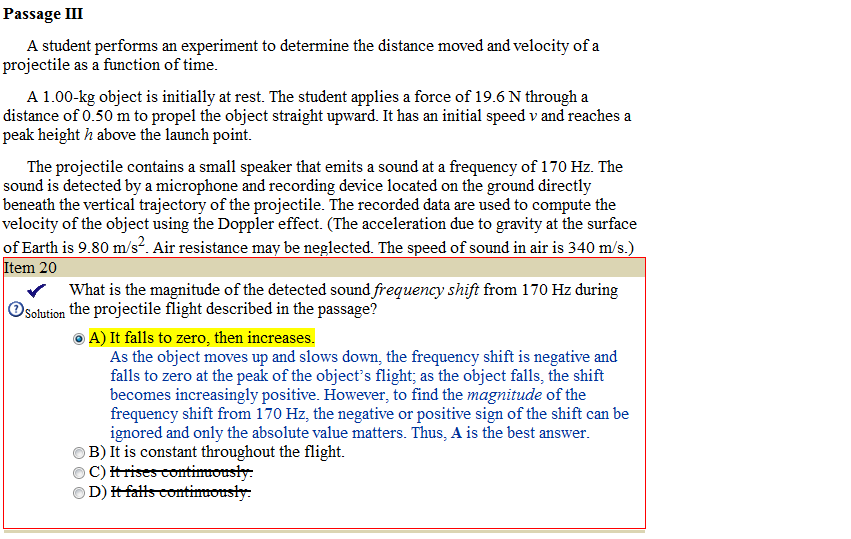- Joined
- Dec 1, 2011
- Messages
- 18,577
- Reaction score
- 57
Doppler Effect isn't a problem for me, but I am a little confused about the wording of the question and the explanation. As with any Doppler question, if the object/source have a net movement away from each other, the observed frequency will be lower. So in this problem, as the projectile gets higher, the observed frequency decreases. Though it is approaching 0, the frequency won't actually ever be 0 right?
From the explanation, "frequency shift" seems like it is the same as "change in frequency" and I guess is also the same as "doppler shift". So when the velocity of the projectile hits 0 (at hmax) the frequency shift is 0 (since it is no longer changing because the object/source aren't moving relative to each other) but the overall frequency is still a non-zero number?
So to break this down into really simple and non-physics terms. When the projectile is first shot its velocity is very high since gravity hasn't started to decelerate it yet. Remembering that overall distance is irrelevant in Doppler problems, we consider only that the velocity is very high initially so the Doppler shift ("frequency shift"??) is the greatest. Then as it reaches its max height, it has been decelerated continuously by gravity so its velocity is 0 so the frequency shift is not changing (=0). Then it accelerates downwards and velocity increases even though the distance is decreasing (distance doesn't affect doppler!).
tl&dr: Just wanted to verify that the term "frequency shift" is exactly the same thing as "doppler shift"

From the explanation, "frequency shift" seems like it is the same as "change in frequency" and I guess is also the same as "doppler shift". So when the velocity of the projectile hits 0 (at hmax) the frequency shift is 0 (since it is no longer changing because the object/source aren't moving relative to each other) but the overall frequency is still a non-zero number?
So to break this down into really simple and non-physics terms. When the projectile is first shot its velocity is very high since gravity hasn't started to decelerate it yet. Remembering that overall distance is irrelevant in Doppler problems, we consider only that the velocity is very high initially so the Doppler shift ("frequency shift"??) is the greatest. Then as it reaches its max height, it has been decelerated continuously by gravity so its velocity is 0 so the frequency shift is not changing (=0). Then it accelerates downwards and velocity increases even though the distance is decreasing (distance doesn't affect doppler!).
tl&dr: Just wanted to verify that the term "frequency shift" is exactly the same thing as "doppler shift"

